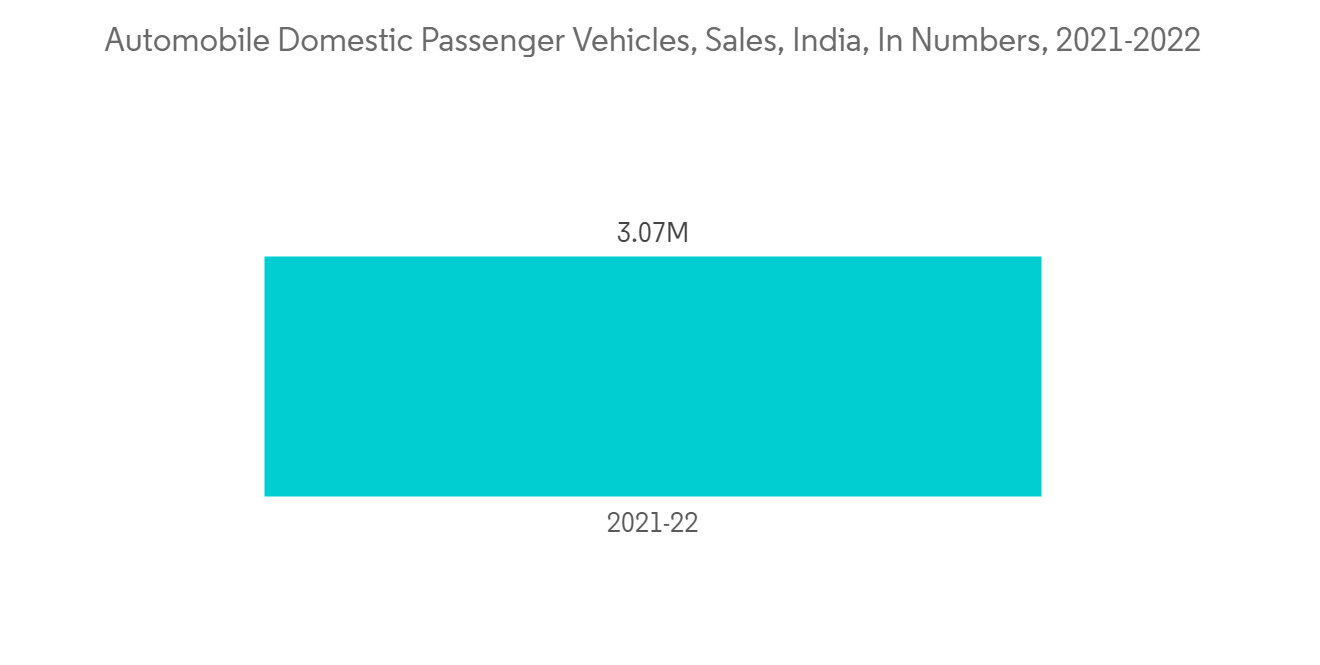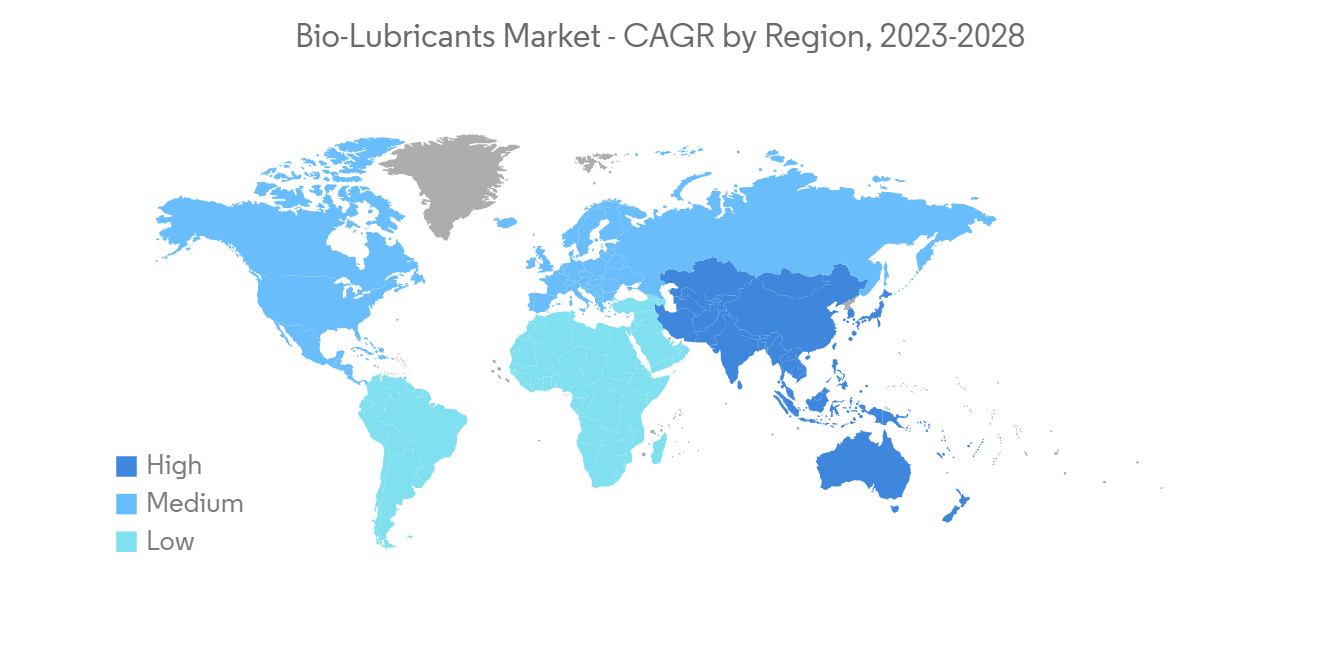 |
市場調查報告書
商品編碼
1272699
生物潤滑油市場——增長、趨勢和預測 (2023-2028)Bio-Lubricants Market - Growth, Trends, and Forecasts (2023 - 2028) |
||||||
價格
※ 本網頁內容可能與最新版本有所差異。詳細情況請與我們聯繫。
簡介目錄
在預測期內,生物潤滑油市場預計將以超過 3% 的複合年增長率增長。
主要亮點
- COVID-19 對 2020 年的市場產生了負面影響。 不過,預計市場將在2022年達到疫情前的水平,並繼續保持穩定增長。
- 生物基潤滑劑不會引起通常由石油基潤滑劑引起的皮膚刺激。 此外,還有各種優勢,如減少能源使用和勞動力成本、提高員工安全、改善環境條件、延長機器壽命和增加產量,這些都在推動市場的增長。
- 生物潤滑劑是通過脂肪酸的酯化或植物油的酯交換產生的。 該步驟是在均相酸/鹼催化劑 8-10 存在下或使用離子交換樹脂用長鏈醇進行的。 這個過程增加了生物基潤滑劑的成本。 這被認為會阻礙市場增長。
- 已完成各種研究和開發項目,以提高生物基潤滑油的物理化學性能。 這些研究發現,生物基潤滑油可以作為石油基油品的替代品,有望成為市場機遇。
- 亞太地區主導著全球市場,中國、印度和日本等國家/地區的消費量最大。
生物潤滑油市場趨勢
汽車和運輸領域對生物潤滑油的需求不斷擴大
- 汽車和運輸行業在生物潤滑油市場佔有很大份額。 運輸行業專注於提高潤滑油性能,例如性能、壽命、能源效率和環境友好性。 Biogrease 適用於各種應用,包括建築車輛、林業設備、鐵路法蘭、鐵路曲線和導航設備。
- 許多行業都在使用生物基金屬切削液和冷卻劑進行磨削、齒輪切削和通用機械加工,這有望推動市場增長。 生物基潤滑油具有毒性低、粘度指數高、潤滑性能強、機器壽命長、燃燒溫度高等特點,有望在汽車行業中逐步超越傳統潤滑油。
- 中國汽車工業的擴張預計會打開對生物潤滑油的需求。 根據國際汽車製造商協會 (OICA) 的數據,中國是最大的汽車生產國。 2021 年僅中國就將生產 26,082,220 輛汽車。
- 在印度,乘用車和商用車的銷量大幅增長。 例如,2021-2022年國內乘用車銷量為3,069,499輛,較2020-21年增長13%。 預計所有上述因素都將在預測期內推動全球市場。

亞太地區主導市場
- 中國是亞太地區第三大生物潤滑油消費國。 該地區發電行業的擴張預計將在預測期內推動生物潤滑油市場。
- 2021 年,印度的可再生能源裝機容量超過 147.1 吉瓦。 這超過了 2020 年研究期間 134.5 GW 的峰值,極大地支持了市場的增長。
- 2021 年中國的發電量約為 8377 太瓦時。 這比上一年增長了近10%。 2021年除水電外的所有能源消耗量都將增加,風能和太陽能的使用量將增加。
- 此外,日本政府還計劃在國內新建 45 座採用優質黑煤的高能低排放技術的燃煤電廠。 隨著該國發電廠數量的增加,預計在預測期內對發電廠使用的生物潤滑油的需求將加速增長。
- 因此,預計電力行業的這種增長將推動亞太地區的生物潤滑油市場。

生物潤滑油行業概況
生物潤滑油市場因其性質而分散。 市場主要參與者包括 BP p.l.c.、雪佛龍公司、埃克森美孚公司、TotalEnergies、FUCHS 等。
其他福利:
- Excel 格式的市場預測 (ME) 表
- 3 個月的分析師支持
內容
第一章介紹
- 調查結果
- 本次調查的假設
- 本次調查的範圍
第二章研究方法論
第 3 章執行摘要
第四章市場動態
- 主持人
- 監管規範推動了對生物基潤滑油的需求
- 其他司機
- 約束因素
- 生物基潤滑油價格高
- 其他抑製劑
- 工業價值鏈分析
- 波特的五力分析
- 供應商的議價能力
- 消費者的議價能力
- 新進入者的威脅
- 替代品的威脅
- 競爭程度
第 5 章市場細分(市場規模:基於金額)
- 產品類型
- 機油
- 變速箱/液壓油
- 金屬加工油
- 一般工業用油
- 齒輪油
- 潤滑脂
- 工藝油
- 其他產品類型
- 最終用戶行業
- 發電廠
- 汽車和其他運輸設備
- 重型機械
- 食物和飲料
- 冶金和金屬加工
- 化學工業
- 其他最終用戶行業
- 地區
- 亞太地區
- 中國
- 印度
- 日本
- 韓國
- 其他亞太地區
- 北美
- 美國
- 加拿大
- 墨西哥
- 其他北美地區
- 歐洲
- 德國
- 英國
- 意大利
- 法國
- 俄羅斯
- 其他歐洲
- 南美洲
- 巴西
- 阿根廷
- 其他南美洲
- 中東和非洲
- 沙特阿拉伯
- 南非
- 阿拉伯聯合酋長國
- 其他中東和非洲地區
- 亞太地區
第六章競爭格局
- 併購、合資、合作、合同等。
- 市場份額 (%)**/排名分析
- 各大公司的招聘策略
- 公司簡介
- Axel Christiernsson
- Carl Bechem Lubricants India Private Limited
- BP p.l.c.
- Cargill
- Chevron Corporation
- Cortec Corporation
- Environmental Lubricants Manufacturing, Inc.
- Exxon Mobil Corporation
- FUCHS
- KCM Petro Chemicals
- Novvi, LLC.
- PANOLIN AG
- Shell plc
- TotalEnergies
第七章市場機會與未來趨勢
- 推出性能更好的新產品
簡介目錄
Product Code: 55763
The bio-lubricants market is projected to register a CAGR of more than 3% during the forecast period.
Key Highlights
- COVID-19 negatively impacted the market in 2020. However, the market reached pre-pandemic levels in 2022 and is expected to grow steadily in the future.
- Bio-based lubricants do not cause skin inflammation, which is generally caused by petroleum-based lubricants. Additionally, they have various advantages, such as reduced energy usage, labor costs, increased employee safety, improved environmental conditions, increased machine life, and increased production, thereby augmenting the market's growth.
- Bio-lubricants are produced by esterifying a fatty acid or trans-esterifying vegetable oil. This process is being held with long-chain alcohol in the presence of a homogeneous acid/base catalyst 8 -10 or using an ion-exchange resin. This process increases the cost of bio-based lubricants. This is likely to hinder the market's growth.
- Various R&D projects have been completed to improve the physicochemical properties of bio-based lubricants. These studies have found that bio-lubricants can be used as substitutes for petroleum-based oils and are projected to act as an opportunity for the market.
- The Asia-Pacific region dominated the global market, with the largest consumption from countries such as China, India, and Japan.
Bio-Lubricants Market Trends
Increase in Demand for Bio-Lubricants in Automotive and Transportation Sector
- The automotive and transportation sector accounts for a considerable share of the market for bio-lubricants. The transportation industry emphasizes enhancing lubricant properties such as performance, longevity, energy efficiency, and environmental friendliness. Bio-greases work well in various applications, including construction vehicles, forestry machinery, rail flanges, rail curves, and nautical machinery.
- Many industries use bio-based metal cutting fluids and coolants for grinding, gear cutting, and general machining, which are anticipated to drive market growth. Due to their low toxicity, high viscosity index, potent lubricating properties, longer machine service life, high combustion temperature, and other characteristics, bio-based lubricants are expected to displace conventional lubricants in the automotive industry eventually.
- The expansion of the automotive sector in China is anticipated to cultivate the demand for bio-lubricants. According to the International Organization of Motor Vehicle Manufacturers (French: Organisation Internationale des Constructeurs d'Automobiles) (OICA), China is the largest producer of automobiles. The country alone produced 2,60,82,220 units of vehicles in 2021.
- Also, India witnessed a significant increase in the sales of passenger vehicles and commercial vehicles. For instance, the domestic sales of passenger vehicles were 3,069,499 for 2021-2022, representing an increase of 13% compared to 2020-21. All the aforementioned factors are expected to drive the global market during the forecast period.

Asia-Pacific to Dominate the Market
- China is the third largest bio-lubricant consumer in the Asia-Pacific region. The expanding power generation industry in the region is anticipated to drive the bio-lubricant market during the forecast period.
- In 2021, India had a capacity for more than 147.1 gigawatts of renewable energy. This was higher than the peak for the period under consideration in 2020, which was 134.5 gigawatts, supporting the market's growth significantly.
- Around 8,377 terawatt hours of electricity were produced in China in 2021. This was an increase over the previous year of almost 10%. Except for hydropower, all energy sources were more significantly consumed in 2021, with wind and solar power generating increases being majorly used.
- Moreover, the Japanese government has also been planning to build 45 new coal-fired power plants in the country by using high-energy, low-emission technology, which uses high-quality black coal. With the increasing number of power plants in the country, accelerated demand for bio-lubricants for use in power plants is expected during the forecast period.
- Therefore, this increase in the power industry is expected to drive the bio-lubricants market in the Asia-Pacific region.

Bio-Lubricants Industry Overview
The bio-lubricants market is fragmented in nature. Some of the major players in the market include BP p.l.c., Chevron Corporation., Exxon Mobil Corporation, TotalEnergies, and FUCHS, among others
Additional Benefits:
- The market estimate (ME) sheet in Excel format
- 3 months of analyst support
TABLE OF CONTENTS
1 INTRODUCTION
- 1.1 Study Deliverables
- 1.2 Study Assumptions
- 1.3 Scope of the Study
2 RESEARCH METHODOLOGY
3 EXECUTIVE SUMMARY
4 MARKET DYNAMICS
- 4.1 Drivers
- 4.1.1 Regulatory Norms Driving the Demand for Bio-based Lubricants
- 4.1.2 Other Drivers
- 4.2 Restraints
- 4.2.1 High Price of Bio-based Lubricants
- 4.2.2 Other Restraints
- 4.3 Industry Value-Chain Analysis
- 4.4 Porter's Five Forces Analysis
- 4.4.1 Bargaining Power of Suppliers
- 4.4.2 Bargaining Power of Consumers
- 4.4.3 Threat of New Entrants
- 4.4.4 Threat of Substitute Products and Services
- 4.4.5 Degree of Competition
5 MARKET SEGMENTATION (Market Size in Value)
- 5.1 Product Type
- 5.1.1 Engine Oil
- 5.1.2 Transmission and Hydraulic Fluid
- 5.1.3 Metalworking Fluid
- 5.1.4 General Industrial Oil
- 5.1.5 Gear Oil
- 5.1.6 Grease
- 5.1.7 Process Oil
- 5.1.8 Other Product Types
- 5.2 End-user Industry
- 5.2.1 Power Generation
- 5.2.2 Automotive and Other Transportation
- 5.2.3 Heavy Equipment
- 5.2.4 Food & Beverage
- 5.2.5 Metallurgy & Metalworking
- 5.2.6 Chemical Manufacturing
- 5.2.7 Other End-user Industries
- 5.3 Geography
- 5.3.1 Asia-Pacific
- 5.3.1.1 China
- 5.3.1.2 India
- 5.3.1.3 Japan
- 5.3.1.4 South Korea
- 5.3.1.5 Rest of Asia-Pacific
- 5.3.2 North America
- 5.3.2.1 United States
- 5.3.2.2 Canada
- 5.3.2.3 Mexico
- 5.3.2.4 Rest of North America
- 5.3.3 Europe
- 5.3.3.1 Germany
- 5.3.3.2 United Kingdom
- 5.3.3.3 Italy
- 5.3.3.4 France
- 5.3.3.5 Russia
- 5.3.3.6 Rest of Europe
- 5.3.4 South America
- 5.3.4.1 Brazil
- 5.3.4.2 Argentina
- 5.3.4.3 Rest of South America
- 5.3.5 Middle East & Africa
- 5.3.5.1 Saudi Arabia
- 5.3.5.2 South Africa
- 5.3.5.3 United Arab Emirates
- 5.3.5.4 Rest of Middle East & Africa
- 5.3.1 Asia-Pacific
6 COMPETITIVE LANDSCAPE
- 6.1 Mergers & Acquisitions, Joint Ventures, Collaborations, and Agreements
- 6.2 Market Share(%)**/Ranking Analysis
- 6.3 Strategies Adopted by Leading Players
- 6.4 Company Profiles
- 6.4.1 Axel Christiernsson
- 6.4.2 Carl Bechem Lubricants India Private Limited
- 6.4.3 BP p.l.c.
- 6.4.4 Cargill
- 6.4.5 Chevron Corporation
- 6.4.6 Cortec Corporation
- 6.4.7 Environmental Lubricants Manufacturing, Inc.
- 6.4.8 Exxon Mobil Corporation
- 6.4.9 FUCHS
- 6.4.10 KCM Petro Chemicals
- 6.4.11 Novvi, LLC.
- 6.4.12 PANOLIN AG
- 6.4.13 Shell plc
- 6.4.14 TotalEnergies
7 MARKET OPPORTUNITIES AND FUTURE TRENDS
- 7.1 Introduction of New Products with Better Properties
02-2729-4219
+886-2-2729-4219













